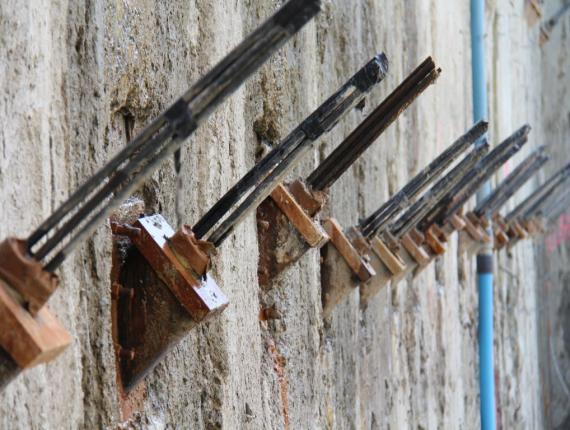Key Differences Between Manta Ray anchors and Screw Anchors
Wiki Article
Exactly How Heavy-Duty Earth Anchors Job: A Comprehensive Guide to Dirt Anchoring Solutions
Heavy-duty Earth supports play a vital function in giving stability and support in numerous construction applications. By embedding deeply into the ground, they stand up to lateral and upright pressures successfully. Different kinds of anchors accommodate various dirt problems, making them versatile. Recognizing their auto mechanics and installment strategies is essential for taking full advantage of efficiency. What factors influence their performance, and how do they compare to typical methods? The responses may stun you.Recognizing Durable Earth Anchors
Sturdy Earth anchors work as important components in different building and landscaping jobs, giving security and assistance in difficult soil conditions. These supports work by being installed right into the ground, where they withstand vertical and lateral pressures. Their design enables safe and secure accessory to structures, ensuring they stay secured versus soil movement or outside loads.The effectiveness of sturdy Earth anchors mainly depends on the kind of soil and the anchor's installment deepness. Correct installation methods are critical, as they identify the anchor's holding capability. Environmental factors, such as moisture and freeze-thaw cycles, can likewise impact performance.These anchors are often used in applications ranging from protecting fences and maintaining wall surfaces to maintaining short-lived frameworks during damaging climate condition. Recognizing the concepts behind sturdy Earth supports is essential for experts seeking to improve the resilience and security of their tasks.Sorts Of Heavy-Duty Earth Anchors
Different kinds of durable Earth anchors are developed to satisfy certain demands based on dirt problems and task demands. Helical anchors, including screw-like blades, are reliable in softer dirts, providing high load abilities and easy installment. Driven anchors, which are hammered into the ground, appropriate for rough terrains and provide prompt load assistance. Tie-back supports are generally made use of in preserving wall applications, enabling side support by anchoring into the ground at an angle. An additional kind is the cast-in-place support, ideal for concrete applications, as they are integrated right into structures for boosted stability. Soil screw supports are versatile alternatives that can be made use of in different dirt types, supplying dependable stress and compression abilities. Each type offers unique applications, making sure stability and security in construction and landscaping projects. Comprehending these options permits notified decisions in choosing the suitable Earth securing service.The Mechanics of Soil Anchoring

Comprehending the mechanics of soil anchoring calls for an evaluation of numerous kinds of Earth supports and their installation methods. Each support kind provides unique attributes that influence its effectiveness in different dirt problems. Appropriate setup methods are important for taking full advantage of the securing system's stability and performance.
Sorts Of Earth Anchors
Earth anchors, important parts in dirt anchoring systems, can be found in a number of types, each made for details applications and dirt problems. The most typical kinds include screw anchors, which are turned right into the ground, providing strong lateral resistance. Helical anchors feature blades that permit reliable setup in numerous soil kinds, making them ideal for both momentary and irreversible applications. Driven anchors, commonly made from steel, are inculcated the soil and work in rough or thick environments. Auger anchors use a helical design to facilitate installation in softer soils. Plate anchors consist of a level plate buried horizontally, dispersing tons over a bigger location, suitable for applications requiring high lots capabilities in natural soils.Installation Methods Explained
Correct installation techniques are important for the efficiency of dirt anchoring systems. The process commonly starts with website assessment, validating the selected area can sustain the anchor's load. After identifying the right support type, appropriate opening deepness and angle have to be developed. The setup includes driving the support into the ground using specific devices, such as hydraulic or hands-on motorists, to accomplish finest embedment. Post-installation, tensioning the anchor is vital to ensure stability; this is commonly confirmed with lots screening. Furthermore, surrounding soil conditions must be monitored to avoid variation. Adhering to these techniques not just improves the anchor's efficiency yet likewise extends its life-span, providing reliable assistance for numerous applications.Applications of Heavy-Duty Earth Anchors
While sturdy Earth supports are frequently linked with construction and landscape design, their versatility encompasses a selection of applications across different industries. In civil design, they give important support for preserving walls, ensuring stability in locations susceptible to dirt erosion. The aquatic field makes use of these supports for securing anchors and marinas, preventing activity triggered by currents and trends. Additionally, in the telecommunications market, heavy-duty Earth anchors are significant for stabilizing cell towers and various other tall frameworks against wind forces. Agricultural applications additionally benefit, as these supports can protect structures like greenhouses and livestock fencing, guaranteeing they hold up against rough weather problems. In addition, in renewable resource tasks, such as wind ranches, Earth supports play a vital function in protecting turbine foundations, improving overall safety and performance. This broad variety of applications highlights the flexibility and dependability of sturdy Earth anchors throughout various areas.Advantages Over Traditional Anchoring Techniques
Traditional anchoring approaches have long been depended upon for stability, durable Earth supports offer significant advantages that boost efficiency and effectiveness. One significant benefit is their superior load-bearing ability, which permits them to stand up to better forces without failure. This strength makes them suitable for demanding applications, such as in construction and utility installations.Additionally, durable Earth supports are created for much deeper installment, providing higher stability in various soil problems, consisting of loosened or sandy soils. Their resistance to deterioration and ecological factors ensures a longer life-span and minimized maintenance expenses compared to conventional methods.Moreover, these anchors can be mounted with marginal disturbance to the surrounding area, protecting the stability of the landscape. On the whole, sturdy Earth anchors provide a reputable and efficient remedy for anchoring demands, surpassing the restrictions typically related to standard anchoring methods.Setup Process and Ideal Practices
The setup procedure for soil anchoring remedies begins with extensive prep work and site evaluation to assure peak efficiency. Following this, a detailed installation guide web provides clear instructions for reliable implementation (heavy-duty earth anchors). Abiding by these finest methods is important for accomplishing durable and dependable anchoring outcomesPrep Work and Website Evaluation
Effective preparation and extensive website examination his response are important steps in the installation of soil anchoring services. Prior to setup, the dirt kind have to be evaluated to determine its bearing ability and viability for securing. Performing a geotechnical study can offer essential details regarding soil structure, dampness degrees, and prospective ground activity. Additionally, recognizing existing structures, vegetation, and utilities is necessary to avoid interference during installation. The area should be removed of debris and obstacles to assure secure accessibility for devices. Climate conditions ought to also be kept an eye on, as adverse conditions can impact both security and setup efficiency. By meticulously preparing the website and examining all pertinent aspects, the probability of effective support efficiency is substantially boosted.Step-by-Step Installment Guide
A detailed installment process is essential for achieving excellent performance of soil securing solutions. The setup starts with picking the ideal anchor type and guaranteeing the site is free from particles. Next off, correct hole positioning is figured out based upon tons requirements. Once the area is established, openings are pierced to the defined depth and diameter utilizing the appropriate devices. The support is after that put right into the opening, seeing to it it is lined up appropriately. After safeguarding the support, dirt is backfilled and compacted to boost security. It is vital to comply with producer standards throughout the process. A post-installation assessment verifies that the anchors are properly located and operating as planned, supplying trustworthy support for the designated application.
Upkeep and Evaluation of Earth Anchors
Routine maintenance and assessment of Earth anchors are essential for making sure lasting performance and security. Regular checks enable the early detection of concerns such as deterioration, loosening, or soil motion. Assessors must look for indicators of corrosion or destruction on the support components, particularly at the link factors. Furthermore, the bordering soil must be evaluated for disintegration or adjustments in dampness web content, which can influence anchor effectiveness.It is a good idea to establish a routine assessment routine, preferably at the very least annually, depending on ecological conditions. During examinations, all noticeable components need to be cleansed to remove dust or particles that can conceal possible issues. Any signs of distress, such as tilting structures or uncommon settling, should trigger immediate examination. Appropriate documentation of evaluations can assist in tracking support performance with time and facilitate prompt upkeep activities, making sure the supports continue to be functional and reliable.Often Asked Inquiries
What Materials Are Heavy-Duty Earth Anchors Usually Made From?
Sturdy Earth supports are normally created from durable products such as galvanized steel or stainless-steel, guaranteeing strength and resistance to deterioration. These products provide long-lasting assistance and security in different soil conditions and applications.Just How Do Soil Problems Impact Anchor Efficiency?
Soil conditions significantly affect support performance. Aspects such as soil kind, dampness content, and compaction influence the support's grip and security, with cohesive soils often giving much better resistance than loosened or sandy dirts, affecting overall effectiveness.
Can Heavy-Duty Earth Anchors Be Reused After Elimination?
Heavy-duty Earth supports can be recycled after elimination, offered they are evaluated for damage and wear. Proper cleaning and upkeep improve their long life, ensuring reliable performance in succeeding installments when problems enable safe reinstallation.What Are the Environmental Impacts of Making Use Of Earth Anchors?
The ecological effects of utilizing Earth supports consist of prospective dirt disturbance, disturbance of regional communities, and possible contamination of groundwater. If used responsibly, their benefits usually surpass these worries, promoting stability in different applications.Exactly how Do I Choose the Right Support for My Project?

Report this wiki page